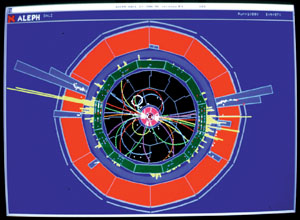by Maurice Jacob, Editions Odile Jacob, ISBN 2738109802.

In this topical book, CERN theorist Maurice Jacob glibly traces the evolution of our understanding of the underlying structure of matter, from atoms to quarks – and its implications for cosmology. While the subject is not easy, the author manages to attain a remarkably deep level of insight without writing any equations. The many difficult concepts encountered en route are not glossed over or paraphrased (even though some of them could be). The presentation of the “Schrödinger’s cat” enigma is well done. A few explanations, like parity violation, would have benefited from an explanatory diagram. However, event displays from CERN’s LEP collider provide vivid examples of basic types of interaction.
An introduction manages to bring into the very first paragraph the enigma of quarks – unlike all other constituents of nature, quarks resist being isolated. The meat of the book goes on to trace in detail the mechanisms of the microworld, to climax on the one hand with the Standard Model and the state of particle physics today and on the other its implications for the Big Bang and the birth of the universe, which was initially just a big particle physics experiment.
Then comes a series of essays examining basic questions – the baffling concept of time, antimatter and the structure of the vacuum. Two more chapters look at the sociology of particle physics – how post-Second World War collaboration between scientists has catalysed new international understanding and helped overcome political barriers once perceived as insurmountable, and how this collaboration has attained a truly planetary level for the construction of the new LHC collider at CERN.
The final chapter examines the value of particle physics and its contributions to other branches of science – imaging for medicine and other applications, high-performance detectors, new techniques for data handling and parallel computing and underlines the value of research in education and training.
The book always uses CERN as its focus and reflects the vision of the organization’s spiritual fathers like Louis de Broglie who first saw the need for large-scale international scientific collaboration amid the ruins of post-war Europe.







